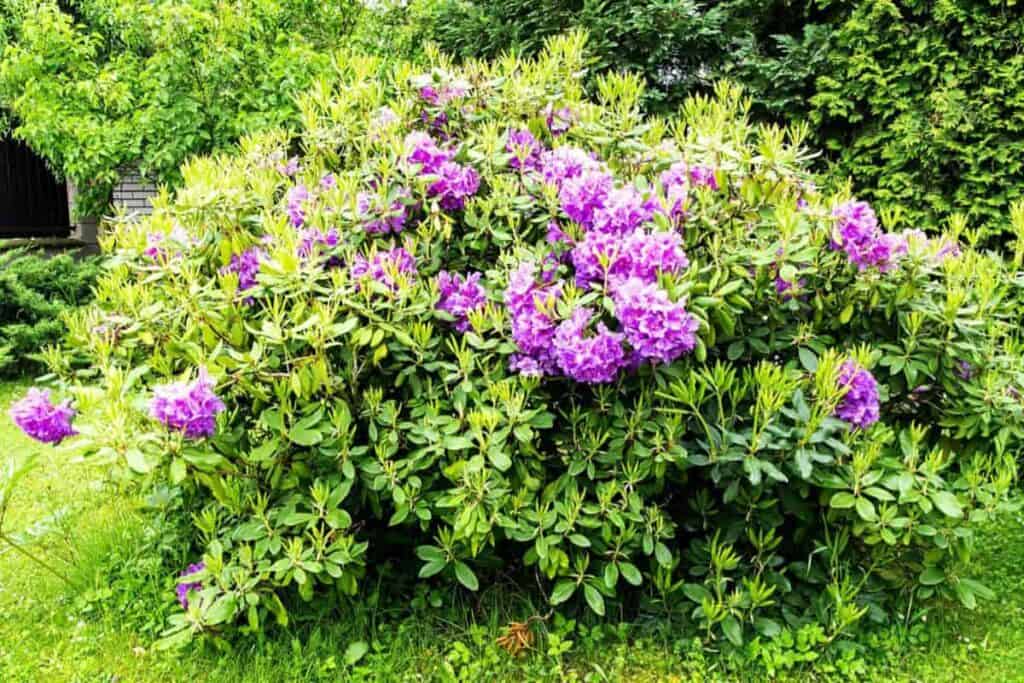Trends in gardening sometimes result in certain flowers being found less often in American gardens today. Rhododendrons are an example of an old-fashioned flower that has reversed the trend.
The rhododendron group is so large (over 800 species and several thousand named varieties) that suitable types can be found for almost every size and style of garden.

We do not too often see the magnificent giants, which were a favorite on many of the large, old estates. These varieties rapidly grow, soon out of scale in more modest gardens.
But for these smaller gardens, many other rhododendrons can be used not only as specimen plants but in the shrub border, for screens and hedges, as accent plants, in rock gardens, under windows, or next to steps, gates, and so on.
For Modern Homes
For modern homes, particularly where the house is low, or garden space is limited, two groups of rhododendrons are especially appropriate.
One is the group generally referred to as azaleas. These I shall bypass at this time, although there are wide, low, spreading varieties in this group.
The other is the less well-known but exceedingly attractive group of dwarf rhododendrons. There are many of these, but certain types are outstanding. Hybrids of R. williamsianum, like Bow Bells, Arthur J. Ivens, Jock, and Temple Belle, are particularly neat plants.
The leaves are usually rounded and offer a welcome contrast to the other foliage, winter and summer.
Rhododendron Varieties
Another type has rather small leaves and smallish blue flowers. A few varieties are:
- Blue Diamond
- Blue Tit
- Sapphire
Dwarf Red Variety
- Elizabeth, with relatively large flowers, is very well-liked in the Northwest.
- Ramapo originated in New Jersey and is believed to be hardier than the varieties above. It makes a neat-appearing dwarf with small leaves and pinkish-mauve flowers.
Other Low-Growing Varieties
- Early-blooming Bric-a-brac (white)
- Conemaugh (lavender pink)
- Racial (shell pink)
- Later blooming is Humming Bird (pink with vermilion tones)
- Moonstone (cream).
All these are excellent in front of the larger rhododendrons or other evergreens, especially in rock gardens and near the house, where they can be enjoyed at close range.
There is a variation in the hardiness of the dwarf varieties, just as there is with the larger growing sorts. Some are relatively tender, and others are hardy to temperatures well below zero.
But, as with nearly all flowering plants, there is always a need for still hardier varieties. Hybrids of R. yakushimanum may partially fill this need, a species only recently introduced into this country from Japan.
Already a few hybrids between this and other species have been grown and are attracting considerable attention.
Breeding Of Harder Varieties
The breeding of hardier varieties and many other subjects of widespread interest will be discussed in detail at the International Conference, which the American Rhododendron Society is holding in Portland, Oregon, from May 11 to 14.
There will be speakers from New Zealand, Holland, England, and Germany, as well as from this country and Canada. (A program may be obtained by writing to Mrs. Ruth M. Hansen, 3514 N. Russet Street, Portland 17, Oregon.)
Rhododendron Test Garden In Portland
Visitors to the Northwest should make a point to see the rhododendron test garden in Portland. This outstanding garden, located on an island in a small lake, contains an unusually complete collection of rhododendron species and also offers an opportunity to see the modern, low-spreading varieties so well adapted to current building and garden trends.
This is not intended to be a cultural story, but I want to report one very useful discovery. Growers have found that when plants suffering from obvious nitrogen shortage are fed nitrate of soda, they often fail to respond.
The reason is that rhododendrons, like most other heath family members, prefer their nitrogen in the ammonia form. Feed them ammonium sulfate, and the results will be dramatic.
44659 by J. Harold Clarke
